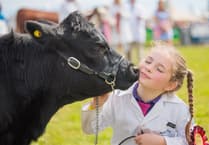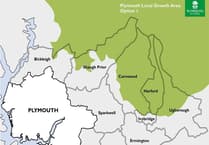A seaweed farm, which could be the first of its kind, is planned for Start Bay.
Dr Angela Mead, a scientist and researcher, who specialises in invasive species, has plans for a research pilot of a seaweed farm in the South West, which could produce biofuels, medicines and bioplastics.
Dr Mead’s company, Biome (Algae) Ltd, has joined forces with the Marine Biological Association, one of the leaders in the field seaweed ecologist Dr Dan Smale, and Dr Philip Kerrison who has at least 10 years experience with this sort of project.
The project will grow two species, sugar kelp and oarweed, both of which are native, local species.
The plan is to harvest growing material from the local area, which will then be transported to the Scottish Association of Marine Science to be embedded into ropes, before being brought back to the farm, where it will grow.
They are put into the water in around September or October and removed for harvesting in around June, meaning the ropes will only be in the bay for nine or 10 months of the year.
Once harvested, the seaweed can be used for third generation biofuels, used in the aviation and maritime industries, for medicines and to create compostable bioplastics.
The area that Dr Mead has earmarked for the farm in Start Bay is an area that cannot be used by demersal fishing boats due to its location and is outside the Marine Conservation Zone.
The farm, measuring 300m x 50m, will consist of ropes anchored to the floor by a brand-new design of anchor, created by Aquamoor Ltd, called embedment anchors – which bolt into the sediment, and drilled rock anchors – which bolt into rock.
The anchors will be deployed by small robots that will be dropped off the side of a boat.
The anchors are only 0.45m², the same size as a crab pot, and they then support the entire 50 tonne seaweed farm. There will be no concrete blocks and no dragging chains.
The whole farm is open, allowing fish and crustaceans to move through it. The farm can create natural drop off and nursery areas, provide food and shelter for fish, crabs and lobsters, hopefully increasing populations.
The entire farm is invisible from the surface as it sits 4m down in the water, with only the buoys being visible. The buoys themselves will be made of a sustainable material and will be coloured and shaped to melt into the environment.
They will light up at night to prevent any boat bumping into it, but it will be probably too deep to cause most boats in the area any trouble.
Dr Mead said: “Positive effects of the seaweed farm include improvements in the water quality and oxygen levels; there’s no added nutrients being added to the system and no waste. It would also act as storm cushioning, encourages tourism and education, and will add to local employment.”
There are some negatives, but Dr Mead hopes they have been mitigated in her plans. There will be a compromise with fishing boats, but the new design will take up much less space, and it will be possible to pot around the farm.
The harvesting will require boats, but Dr Mead hopes to employ local boats with winches to perform the tasks. A win-win situation, it would take place during the quiet time for the fishing boats and would mean that the project wouldn’t have to buy or hire their own boat.
The plans for the farm are about to go out to consultation soon, and you can find out more by visiting www.gov.uk/check-marine-licence-register and search for MLA/2018/00506.
You can also email comments to [email protected]; or by post: Marine Management Organisation, Lancaster House, Hampshire Court, Newcastle upon Tyne, NE4 7YH?In all cases, correspondence must: be received within 28 days of the date of the first notice (13/02/2019); quote the case reference; and include an address to which correspondence relating to the representation or objection may be sent.?The Marine Management Organisation will pass to the applicant a copy of any objection or representation we receive.




Comments
This article has no comments yet. Be the first to leave a comment.